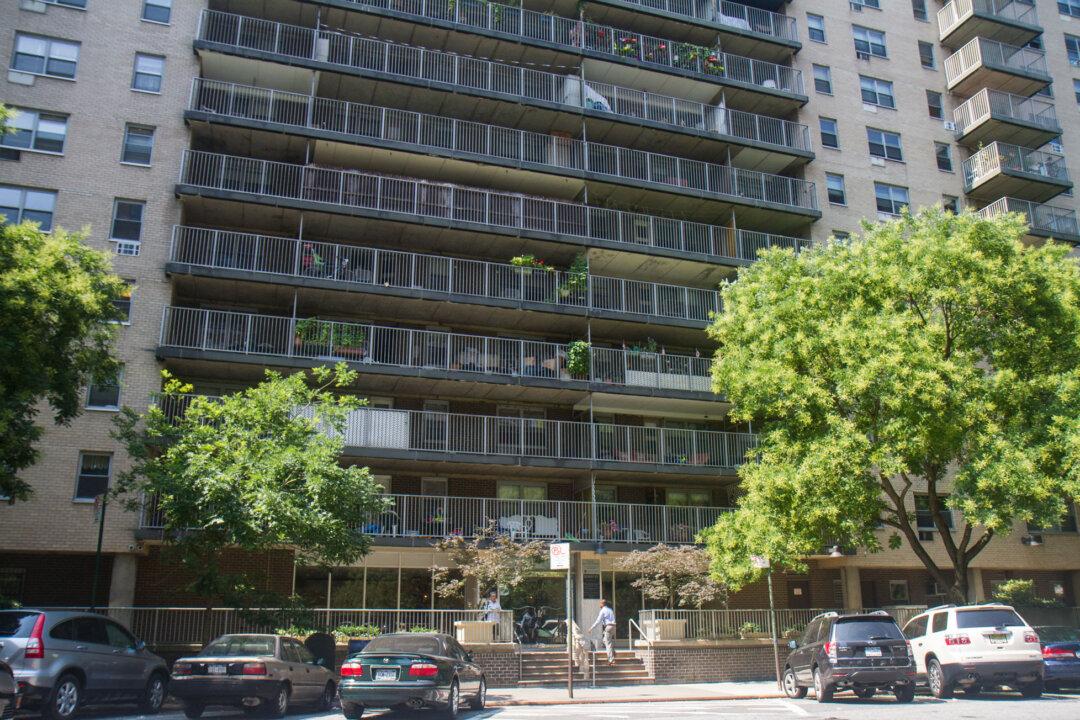NEW YORK—In a luxury rental building on the Upper West Side, on a block bounded on either side by Central Park and a neat row of shops, rent-regulated tenants hold their breath, worrying if they will be the next to have their residence called into question.
Just this week, one tenant received a call over dinner claiming the tenant did not live there. Another received the same frightening message in a letter.
The New York City Rent Stabilization Law stems from a lengthy state-administered Rent Stabilization Code that caps the rent of about 1 million units in the city. Tenants of rent stabilized apartments need to use the apartments as a primary residence, and stay there for a minimum of 183 days a year. A legal proceeding, called a nonprimary holdover, evicts tenants for breaking this law. The proceeding prevents tenants from abusing the system, which is publicly subsidized.
Jeffrey Goldman, co-founder of real estate law firm Belkin Burden Wenig & Goldman, LLP, said in recent years, nonprimary holdovers have been very frequent and a huge problem for his clients.
“Sometimes you have someone who lives in Westchester, who pays $1,000 a month to basically use an apartment on the Upper East Side as a hotel when he’s in the city a few days every now and then,” Goldman, who heads the litigation department, said.
It can be a lengthy process because landlords typically need a year of video surveillance as evidence, and need to have the doorman or building superintendent keep tabs on a tenant suspected of breaking the law.
But it has also gotten easier for landlords, Goldman said, because it doesn’t cost much (sometimes as little as $1,000, he adds) to hire a private investigator to scope out the tenants’ records. “It happens all the time.”
But many tenants are reporting foul play, characterizing the landlords’ behavior as clear tactics to try to get them out of their apartments.
We know your real residence is somewhere else, the caller may state—maybe you live with a sister in Florida, or own a nice house in Georgia. An online search will confirm that there is a person with the same name in another residence, and it is enough for legal action.
One tenant was told no one in the building had seen the tenant in the last couple of months, despite having spent the majority of those months at home recovering from an injury. Another tenant was accused of living out of state despite working long hours, six days a week, at a city job.
It sounds ridiculous initially, but the stressful legal twists and turns that follows the harassment takes a heavy psychological toll.
False Accusations
Sharon Canns is a 41-year resident of the Westwood House at 50 W. 93rd St. beside Central Park, where about 60 percent of the units are still rent stabilized. Since she became president of the building’s tenants association a year ago, she has been scrambling to learn as much as she can about housing laws to help the steady stream of neighbors on the verge of losing their homes.
“We know there are some people doing bad things, breaking the law, in the building too—we do not help them,” Canns makes clear. But in many cases the landlord’s claims are baseless and the tenant is dragged through years of legal proceedings, drowned in paperwork, and forced to take days off work for court hearings, several tenants explained.
The harassment is systemic, and in some cases covert. Hired hands will make phone calls to those living in the building, sometimes dispensing information that isn’t quite true. Some tenants describe the tactics as mind games.
Canns gets two or three people coming to her each month. Just this month six people have needed help keeping their homes. In the last four to five months, the eight-story building lost 10 affordable units.
Sometimes getting the local council member’s office involved is enough to curb the harassment, multiple tenants association leaders said.
Upper West Side
Anna Gago, constituent liaison for Council member Helen Rosenthal of District 6, keeps a bulging binder of housing literature on a bookshelf behind her desk.
“You have SCRIE, DRIE, Mitchell-Lama, rent-controlled, rent-stabilized, what to do if you’re being harassed, what to do if your building isn’t getting repairs, what to do if there’s mold,” Gago lists, flipping through the binder.
Much of it has to do with landlords wanting to turn a profit by deregulating a rent-regulated apartment. “This is a very desirable neighborhood,” Gago said. The district encompasses the Upper West Side. “You have Riverside Park on one side and Central Park on the other. It’s the gold coast of Manhattan.”
But she’s only halfway through the binder. “Rats, bedbugs ... market rate rentals, co-ops—sometimes there’s a dispute over expenses,” Gago said, turning a page. The office can’t give legal advice, but they can help constituents make sense of the situation, learn their rights, and find legal assistance through groups like the Goddard Riverside SRO Law Project.
Not all landlords are predatory, but the ones who are make the tenants lives nightmarish, she said.
As former council member for the district Gale Brewer puts it, the office has seen every housing problem under the sun. Under Brewer, the district opened a monthly housing clinic from October to June to give people legal advice. “I'd say we never had under 50 people,” Brewer said.
Against the back wall of Rosenthal’s district office is a 6-foot-high panel of fliers addressing a multitude of housing problems. The new council member retains the address from Brewer, who is now Manhattan borough president.
“We get about 15 to 20 people coming in with housing issues a day,” said Rosenthal, who has continued to fund the housing clinic. Though her office has been able to help hundreds, many affordable units have been lost since the beginning of the year already.
Every neighborhood’s housing problems are different, Rosenthal adds.
Some communities are trying to stem the tide of gentrification and stop displacement, others are dealing with growing pains. The Upper West Side has been notorious for its shortage of housing supply. In recent decades it has become a coveted neighborhood with diverse housing options, whether people are looking to rent or buy.
Real Estate
In the past year, because of the real estate boom, several institutions have put properties on the market which will be converted into multifamily units, said Paul Smadbeck, senior vice president of sales at publicly traded brokerage Massey Knakal. But the small increase in supply that will bring is not nearly enough to offset the continually decreasing supply.
“Supply is still decreasing; there’s a net annual loss,” said Smadbeck, who has specialized in the neighborhood for over a decade for Massey Knakal Realty Services.
In the 1970s, many townhouses on the Upper West Side were home to individual families. Eventually they were converted into multifamily homes, and now in recent years there has been a trend of converting these from something like a 10-unit building back to a single family home. Every year about 20–30 of these multifamily townhouses are converted, Smadbeck said.
On top of that, summer is the start of the rental season and rental prices have been rising. Rates are now at a five-year high, according to a recent report prepared by appraiser Jonathan Miller.
With about 30,000 rent-stabilized units that net landlords less than $2,500 monthly per unit in the neighborhood, advocates say it is no surprise aggressive tactics are used.
A few weeks ago, Mark Zborovsky put a listing of 41 rent stabilized units on the market, and expects them to go for about $40 million total. Zborovsky is the city’s largest broker of bulk or sponsor units and reported a record year last year. Rent stabilized units often cause landlords to operate at a loss, and those without the patience to convert them into condos or co-ops will portion off just the regulated units to sell to someone else, Zborovsky explains.
“But why would you want to pay $40 million to lose $300,000 in the first year?” Zborovsky asked. Answer: To turn those bleeding units into multimillion condos, or luxury rentals. “When that first unit turns around, you make $3 million in a year,” said Zborovsky.
Usually, a new building owner approaches everyone for a buyout (around $40,000), Zborovsky said. If the tenants don’t want to move, landlords just wait. Dealing with rent-stabilized units is complicated and the group of people buying these units is not a big pool, Zborovsky said, adding that everyone who gets into it is thinking long term.
The majority of rent-stabilized units became regulated decades ago, and the natural attrition rate is about 3 percent every year. Many of the units’ original tenants pass away without leaving the regulated unit to someone in a way that allows the unit to remain rent-stabilized.
This points to the difficulty in preserving affordable housing in the city. Despite Bill de Blasio’s plan to preserve 120,000 affordable units in 10 years (the city has over 1 million) through strategies like increased subsidies and enforcing maintenance of buildings, once a unit exits rent-regulation, there is very little chance of getting it back.
Tactics
Jeffrey McAdams has been a lawyer in landlord-tenant court for 20 years. He said if you live in a rent stabilized apartment, you basically have a target on your back. For years, landlords took tenants to court claiming they did not pay rent. It was common practice even in cases where the tenant had paid the full rent on time. By not cashing the rent checks, the landlord could show the tenant had a bad record, and in some cases the never-ending court proceedings are enough to make the tenant move out.
More recently, “they are getting more creative—and by creative I mean they are twisting the truth,” McAdams said. Tenants can be taken to court because someone else with the same name owns a house, or because a family member lives elsewhere in the city or owns multiple properties, and the landlords will claim the tenant does not live in their rent-regulated apartment as their primary residence.
Nonprimary holdovers are much more complicated than nonpayment cases. To legally initiate such a proceeding, 90–150 days before the tenant’s lease expires the landlord is supposed to give the tenant a notice stating that they believe the apartment isn’t being used as a primary residence and as a result the lease will not be renewed.
But there are tenants reporting receiving calls from lawyers representing their landlords, pressuring them to either take a buyout or face a nonprimary holdover proceeding. The tenant may not know the landlord cannot initiate such a proceeding at the time, and the amount of personal information the lawyer relays over the phone can be frightening.
On Canns’s way to learning everything from state laws on what capital reimbursements landlords can receive from legal proceedings, she has consulted tenant association leaders of two nearby buildings, which are currently owned by Stellar Management.
“We are not unique,” Canns said, “This is happening all over the city.”
When companies come in with the goal of flipping a rent-stabilized building, the cosmetic changes are evident in two ways: major renovations are made to modernize the finishes of vacated units, and a community of homes and neighbors is traded for renters who come and go very quickly.
Since the early 2000s, the tenants in buildings across the city owned by Stellar have been working together, said Sue Susman, president of the Central Park Gardens tenants association.
As of Wednesday, there were nine open landlord-tenant cases between the two buildings Canns and Susman live in. A representative for Stellar said it has a policy of not commenting on landlord-tenant issues.
Susman has been a tenant of her building since about the time it opened, but hadn’t become involved in the tenants association until a few years ago. Her good friend and housing advocate Bob Woolis had always urged her to get involved and when he passed away in 2006, Susman, a former lawyer and law teacher at several universities, felt a sense of responsibility.
After she became president, she realized tenants were receiving these mysterious calls from people telling them a buyout was their only choice. To remedy this, recently she and the tenants association put up bright orange notices in the mailroom with tear-off phone numbers: if you receive a call, contact a lawyer.
They’ve already gone through eight sheets.
“Management has told us they are not happy with that at all,” Susman said. “Well, that’s not our problem.”
Affordable Housing Pressure: Tips and Resources
Under Pressure From Your Landlord?
If a tenant is being pressured out of his or her apartment, seeking legal advice immediately is important. Tenants often end up waiving certain rights they have by not knowing about small, procedural details.
In many cases tenants cannot afford legal services. As such, last month a group of 22 City Council members sponsored a bill to allow tenants to recover legal fees in housing court. For now, there are nonprofits and tenants rights advocacy groups that can connect people to legal services:
Urban Homesteading Assistance Board
120 Wall St., 20th Floor
New York, NY 10005
(212) 479-3300
Legal Aid Society
(212) 577-3300
Housing Conservation Coordinators
777 10th Ave. (between 52nd and 53rd streets)
(212) 541-5996
MFY Legal Services Inc.
299 Broadway, 4th Floor
New York, NY, 10007
(212) 417-3700
Metropolitan Council on Housing
(212) 453-9500
Citizens Committee for New York
77 Water St., Suite 202
New York, NY 10005
(212) 989-0909
CORRECTION: An earlier version of this article misspelled two names. They are Sharon Canns and Sue Susman. Epoch Times regrets this error.





